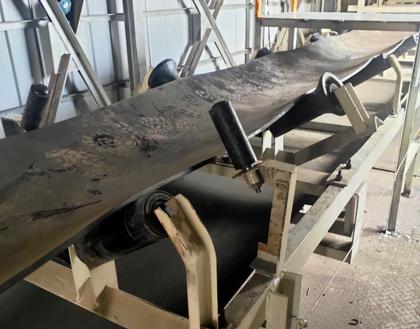The belt conveyor often has the phenomenon of belt deviation during operation. Analysis of the causes and solutions for this phenomenon can ensure the normal operation of the belt conveyor and improve the occurrence of its deviation fault.
The following factors can cause belt deviation:
1. Deviation caused by errors in installation:
1.1The belt conveyor joint is not installed straight, causing uneven tension on both sides of the belt, which can be eliminated by adjusting the tension on both sides of the drive drum and the tail drum.
1.2 The rack is skewed, and the centerline and horizontal tilt of the rack during installation will cause serious deviation of the belt.
1.3 When the guide groove is installed, the pressure of the rubber plates on both sides to the belt is uneven.
2. Belt deviation caused by running:
2.1 Excessive sticky material on the drum and idler leads to belt deviation: The belt is running because the material is sticky or the cleaner does not clean the belt surface. The increase in the outer diameter of the idler roller causes the tension on both sides of the belt to be asymmetrical, which causes the belt to run off.
2.2 Belt deviation caused by loose belt: After the belt has been adjusted and operated for a period of time, the belt will become sag due to the stretching deformation or aging caused by the belt operation, causing the belt to run away.
2.3 Deviation caused by uneven material on the belt: it is caused by incorrect direction and position when the material on the belt falls. Left or right deviation of the material will cause belt deviation.
3. Excessive vibration during the operation of the belt conveyor causes belt deviation:
Excessive vibration during the operation of the belt conveyor will cause the radial jump of the idler to cause vibration. The faster the operation speed, the greater the vibration will cause the belt to run partial.

There are several ways to deal with belt deviation:
1. Deviation caused by errors during installation:
Reinstall the belt conveyor frame when the frame is skewed during installation, and reinstall when the belt joint is not flat.
2. Belt deviation during operation:
2.1 The deviation in the middle of the belt during operation can be achieved by adjusting the position of the roller group.
2.2 Install an automatic self-aligning roller group, each 6-10 groups of the belt conveyor roller group, install a self-aligning roller group to prevent deviation caused by various reasons
3. Installation of the belt stop roller:
When the belt and its deviation are installed, the upper and lower belt stop rollers are installed to prevent the belt from deviation.
4. Adjust the position of the drive roller and the tail redirecting roller:
The drive roller and the redirecting roller should be perpendicular to the center line of the length of the belt conveyor. The drive roller and the tail redirecting roller are not parallel and deviated too much, which will cause the belt to run off. During adjustment, the front and rear positions of the roller bearing seat can be repeatedly adjusted until it is adjusted to a more ideal position.
5. Adjust the tensioning device at the tail of the belt conveyor.
After the belt has been running for a period of time, the tensioning device should be tightened to prevent the belt from being stretched too long and causing deflection.




















